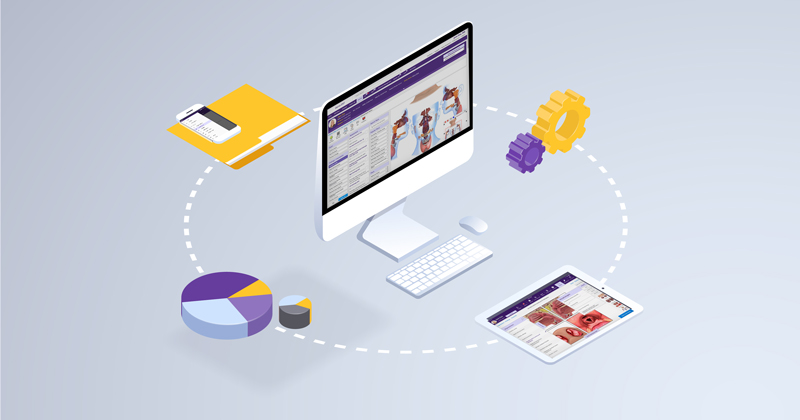Software for ENT Practices: Why a Holistic Approach Matters

Software for ENT Practices: Why a Holistic Approach Matters
As you know, holistic medicine takes a whole-body approach to healthcare. It works to improve health through the body, mind and soul. What if healthcare technology could take the same approach? For example, what if the software for your ENT practice could bring that same sort of Zen-like feeling to your whole practice, helping to restore a sense of normalcy, calm and order, even in the midst of pandemic-fueled chaos? A tall order? Maybe. But let’s think about what’s at stake. Like many specialty medical practices, ENT practices have been hit hard by the pandemic. And otolaryngologists and their staff are considered a high-risk group for infection, due to the very nature of their work: conducting exams, surgeries and other interventions in the head and neck area.1 Adding to an already stressful situation, some practices are also dealing with staffing issues, burnout and, in some cases, real financial hardship.
But yet, there is a proverbial light at the end of the tunnel. Vaccines are rolling out and some practices have decided to use this challenging time as an opportunity to turn the focus inward, finding ways to streamline processes and increase their virtual capabilities—and even improve their revenue cycle in the process. And technology has been an able and willing partner in these improvement efforts. Here’s how ENT software that takes a holistic, all-in-one approach can help bring balance and harmony to your ENT practice, especially during times like these:
Establishing a Solid Foundation With Your ENT EHR
Let’s start by looking closely at one key aspect of your whole practice: your clinical operations. If your physicians are still staying late to complete their notes, we have good news: it doesn’t have to be this way. And despite what your current EHR vendor tells you, there is NO template that fits all, especially when it comes to ENT. Instead, it may be worth considering EHR options that work to eliminate extra clicks and data entry. Software that feels like you designed it yourself. An ENT EHR that has all of the medical content, diagnoses and treatment plans you document the most, already built-in. Side note: ours even includes built-in audiology and allergy modules.
And remember, just because it’s built-in, doesn’t mean it can’t be customized to exactly what you want. EHRs like EMA® enable you to save your most common treatment plans for a particular diagnosis for reuse – again and again. Auto-suggested coding is another innovative feature that’s streamlining the way clinical documentation happens. The best ENT EHRs can actually auto-suggest billing codes based on your clinical documentation for you to review and, if you determine corrections are needed, adjust before you submit the claim.
Staying Connected in a Contactless World
Before the pandemic, doctors were often stuck behind a screen while trying to converse with patients. This, of course, didn’t feel very Zen-like and it certainly didn’t do much to help foster better doctor-patient relationships. However, with the arrival of the pandemic, things only got worse. Suddenly, face-time was actually risky from a health perspective, for both doctors and patients. As a result, many forward-thinking practices decided to add more patient engagement tools to their operations.
According to a 2020 Deloitte survey, “consumers are using virtual visits more than ever before. Consumers using virtual visits rose from 15% to 19% from 2019 to early 2020 and jumped to 28% in April 2020.” The survey also said that most consumers were satisfied with their visits and would use this type of care again.2
While telehealth isn’t ideal for all ENT clinical scenarios, it can be a valuable tool when it comes to setting up new acute care visits for certain complaints, managing medications, conducting post-op visits and wound checks, making referrals to specialists and going over test results.
However, beyond telehealth, there are a number of ways ENT practices can stay connected with patients while social distancing. Many of our clients use patient engagement tools to help facilitate patient check-in and checkout. In fact, a Deloitte survey of physicians found that the proportion of physicians communicating with patients through the EHR (posting test results or notes from the visit to the patient portal or answering quick questions through email) has risen substantially — 38% in 2018 vs. 63% in early 2020.3
And the best ENT EHRs often incorporate these tools to help practices communicate with patients before their appointments. Using these tools, practice staff can send reminders, provide information about updated office hours or policies, let patients know when the doctor is ready to see them and empower them to pay their bill using their method of choice. Patient portals and associated applications can assist patients with updating their medical history, educate them about their condition and remind them of past-due balances.
Making ENT Practice Management a Priority
The second whole practice “system” you’ll want to analyze is your practice operations. If your practice is like most, there are many moving parts. There are appointments being made, patients being ushered from room to room, tests being ordered, results being received and so on. This is another area where the right technology can truly shine. You’d be surprised by how much time can be saved just by deploying the right practice management features–like technology that can transcribe your scanned-in documents, the ability to copy and paste appointments, clearinghouse information—right there in your practice management system, an orders log, intramail, integrated fax information, office flow, and so much more. All of these features are about putting minutes, even hours, back into your day and digitizing everything so it is readily accessible.
Keeping an Eye on ENT Practice Finances
The pressure of keeping up with your practice’s billing cycle has probably never felt so urgent or so necessary. After all, every year U.S. doctors lose an estimated 125 billion dollars in revenue due to poor business practices.4 And that was before the pandemic. Software that can track paid and unpaid claims, and even automate all or a portion of the process, is in high demand. modmed® Otolaryngology even offers a concierge-like financial advisory service through modmed® BOOST. The billing team at modmed BOOST acts as consultants, helping you optimize your revenue cycle, while submitting claims and processing denials on your behalf.
Many practices have also upped their game in terms of analytics and value-based care—all in the name of paying attention to the details and making sure they’re putting in the work to get reimbursed for the care their clinicians provide. One thing to note here is that not all analytics are created equal. Many platforms either can’t give you that 360°-view you need to see how you’re doing financially, or they can’t go deep enough to identify areas of opportunity. Our Premium Analytics platform uses structured data to help you surface actionable data, empowering your practice to make important decisions. You can go as deep or as high-level as you want. Our MIPS dashboard takes a similar approach, showing practices how close they are to reaching their goals in near real time.
Cross-Departmental Efficiency? Yes, Please!
Now, we’d be remiss in our whole-practice analysis if we didn’t include all of the other potential departments (or ancillary services) within your ENT practice. These might include rhinology, sinus, sleep, pediatrics, head & neck, facial plastics and more. How does your current ENT software handle these important entities? Do you have multiple sign-ins to get to different apps or software? Did your tech team build a bridge to a separate audiology application, but now, you’re realizing that it must be broken somewhere because not everything is making it across? Ideally, what you want is a software suite that really brings it all together seamlessly. An all-in-one, and then some, if you will. Who wants to spend more time and money on extra logins and interfaces? And worse…who wants to do all of the extra scanning to get all of your patient documents into your main system? This is why we’re fans of the one-software-suite-for-the-WHOLE-practice approach and why you should be too.
The Time to Regroup and Move Forward is Now
Now is the time to get closer to that Zen-like feeling and finally take action. If you’re still settling for a sub-par piece of software that’s creating inefficiencies, leaving you in the dark in terms of where you stand financially or literally keeping you up at night, there’s no better time to make a change. Right? We know. Just the thought of implementing new software makes you cringe. However, what if that implementation process was done by people who do ENT-specific implementations all year long. And what if that implementation was followed by some serious coaching for your team, both before and after go-live? At Modernizing Medicine®, we don’t implement-and-run (we hear that’s a thing). We stay with you until you’re comfortable with your new system and we continue to provide excellent support thereafter. Which brings us to…
Service That’s Truly Dedicated to ENT
It’s service that understands your ENT practice. The kind that’s empathetic—that knows where you’ve been because we’ve been there ourselves. Not only does our technical team (which includes otolaryngologists) live and breathe ENT, we also have a client services team that specializes in ENT. If you have questions, we find answers. Got feedback? We’re all ears. We provide ENT practices support in multiple ways and we make sure they know we are committed to their success. Period.

Bringing It All Together
Now that you’ve taken the whole-practice journey with us, why not virtually pencil-in some time with one of our associates. We’d love to introduce you to the #1 combination of integrated EHR, Practice Management and revenue cycle management.5